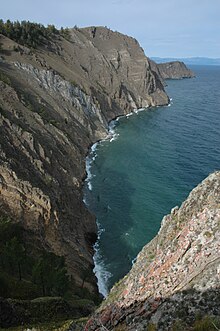Lawa ng Baikal
Ang Lawa ng Baikal (Ruso: о́зеро Байка́л, tr. Ozero Baykal, IPA [ˈozʲɪrə bɐjˈkal]; Russian Buryat: Байгал нуур, Mongol: Байгал нуур, Baygal nuur, nangangahulugang "lawa ng kalikasan";[1]) ay isang lawa na matatagpuan sa timog ng Rusya sa rehiyon ng Siberia, sa pagitan ng Irkutsk Oblast sa hilagang-kanluran at Republika ng Buryat sa timog-silangan.

Ito ang lawang tabang sa daigdig na may pinakamaraming bolyum, na naglalaman ng halos 20% ng mga di-nagyeyelong tubig tabang,[2][3] at nasa lalim na 1,637 metro (5,371 talampakan),[4] ang pinakamalalim.[5] Isa rin ito sa mga pinakamalinaw[6] sa lahat ng mga lawa, at inakalang ang pinakamatandang lawa sa daigdig[7] sa 25 milyong taon.[8] Ito ang ikapitong pinakamalaking lawa sa mundo ayon sa sukat ng kalatagan nito.
Mga sanggunian
baguhin- ↑ Altangerel Damdinsuren, English to Mongolian Dictionary (1998) Silverland: A Winter Journey Beyond the Urals, London, John Murray, pahina 173
- ↑ "Lake Baikal: the great blue eye of Siberia". CNN. Inarkibo mula sa orihinal noong 2006-10-11. Nakuha noong 21 Oktubre 2006.
{{cite news}}: CS1 maint: date auto-translated (link) - ↑ "The Oddities of Lake Baikal". Alaska Science Forum. Inarkibo mula sa orihinal noong 2012-04-19. Nakuha noong 7 Enero 2007.
{{cite web}}: CS1 maint: date auto-translated (link) - ↑ "A new bathymetric map of Lake Baikal. MORPHOMETRIC DATA. INTAS Project 99-1669.Ghent University, Ghent, Belgium; Consolidated Research Group on Marine Geosciences (CRG-MG), University of Barcelona, Spain; Limnological Institute of the Siberian Division of the Russian Academy of Sciences, Irkutsk, Russian Federation; State Science Research Navigation-Hydrographic Institute of the Ministry of Defense, St.Petersburg, Russian Federation". Ghent University, Ghent, Belgium. Inarkibo mula sa orihinal noong 25 Disyembre 2018. Nakuha noong 9 Hulyo 2009.
{{cite web}}: Italic or bold markup not allowed in:|publisher=(tulong)CS1 maint: date auto-translated (link) - ↑ "Deepest Lake in the World". geology.com. Nakuha noong 18 Agosto 2007.
{{cite web}}: CS1 maint: date auto-translated (link) - ↑ Jung, J.; Hojnowski, C., Jenkins, H., Ortiz, A., Brinkley, C., Cadish, L., Evans, A., Kissinger, P., Ordal, L., Osipova, S., Smith, A., Vredeveld, B., Hodge, T., Kohler, S., Rodenhouse, N. and Moore, M. (2004). "Diel vertical migration of zooplankton in Lake Baikal and its relationship to body size" (PDF). Sa Smirnov, A.I.; Izmest'eva, L.R. (mga pat.). Ecosystems and Natural Resources of Mountain Regions. Proceedings of the first international symposium on Lake Baikal: The current state of the surface and underground hydrosphere in mountainous areas. "Nauka", Novosibirsk, Russia (PDF). pp. 131–140. Inarkibo mula sa orihinal (PDF) noong 15 Hunyo 2011. Nakuha noong 9 Agosto 2009.
{{cite book}}:|format=requires|url=(tulong); Unknown parameter|chapterurl=ignored (|chapter-url=suggested) (tulong)CS1 maint: date auto-translated (link) CS1 maint: multiple names: mga may-akda (link) - ↑ Fact Sheet: Lake Baikal — A Touchstone for Global Change and Rift Studies Naka-arkibo 2012-06-29 sa Wayback Machine., Hulyo 1993 (nakuha 4 Disyembre 2007)
- ↑ "Lake Baikal – UNESCO World Heritage Centre". Nakuha noong 5 Oktubre 2012.
{{cite web}}: CS1 maint: date auto-translated (link)
Ang lathalaing ito na tungkol sa Heograpiya at Rusya ay isang usbong. Makatutulong ka sa Wikipedia sa pagpapalawig nito.